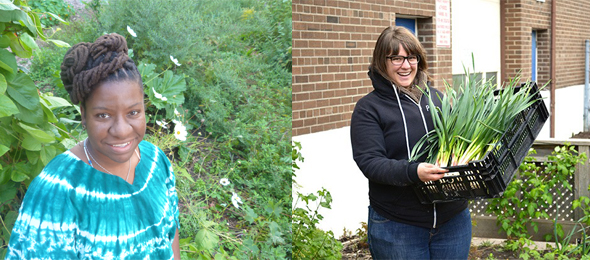When pioneering chef and advocate Alice Waters told the thousand-plus delegates at a recent Farm to Cafeteria conference that “the question of local food is deeply a question of equality,” she struck a chord that had been resonating throughout the conference all week.
Sure, local food is about good health and the environment. It’s about supporting local economies, and making sure farms will be there in the future. It’s about creating new systems of growing and eating. But too often, as many delegates at the conference pointed out, marginalized communities are left out of the discussion.
In the US, research shows that hispanic and black neighbourhoods have fewer grocery stores – and more convenience and fast food outlets – than more affluent, more white neighbourhoods. These so-called “food deserts” mean that people who already have less money to spend on food also have fewer healthy options at their disposal. This is partly why these groups have higher obesity and diabetes rates than the rest of the population.
Canada’s inequality problem
The Canadian context is slightly different; we don’t have the same history of segregation, and we have (for now) a better social safety net than Americans. But we also have communities of colour that suffer disproportionately from hunger and food insecurity.
According to Statistics Canada, the prevalence of household food insecurity (not having reliable access to healthy, safe, sufficient food) is higher amongst recent immigrant households than non-immigrants households. Amongst First Nations, rates of food insecurity are much higher: In 2008, approximately one in five First Nation households (20.9 per cent) was food insecure, compared to 7.5 per cent for the general population. A more recent measure of household food insecurity by province found that Nunavut had the highest rate of food insecurity in the country, at 36.2 per cent of households.
What’s more, StatsCanada surveys found, is that across all food insecure households, adults protected children from hunger to some degree by going without themselves.
Which makes sense. We want to give out kids the best. And, as Waters pointed out, our public schools are an ideal place to foster this equality amongst all kids and begin a radical transformation of our food system.
Put your hands in the soil?
That means making local food relevant to the schools and communities you serve, says Utcha Sawyers. Sawyers is a food justice and community food animation manager with FoodShare Toronto, a non-profit working to ensure everyone has access to “sustainably produced, good healthy food.”
There’s been a pattern, she says, of food organizations coming into communities with little consideration for the culture and ethnicity of that community – something she views as a critical barrier to success. “In all of our programs,” she says, “the model for Foodshare is that the community is our partner, they’re not our clients.”
In a hugely diverse schools system like Toronto’s, this means talking openly about issues of race, inequality and oppression in the food system, says Katie German, coordinator of FoodShare’s School Grown program, a schoolyard farming project that employs students in running urban market gardens.
When she received a batch of applications for this summer’s program, she found they were overwhelmingly white. So she actively sought out more students of colour to apply, and ultimately ended up with a team of 12 that she says better reflects the ethnically diverse makeup of the school.
It also means recognizing that, for students with immigrant parents who have fled rural areas, or those whose ancestors had manual labour forced on them, the phrase “put your hands in the soil!” might not have the same wholesome meaning. “We talk about these things,” says German, “and the students are into it. I think generally, we need to be more willing to have these conversations.”
Food as a bridge
In rural and remote schools, finding culturally relevant ways to engage students around food means something different. Daniel Schulbeck is a math and science teacher at George M. Dawson secondary at Haida Gwaii, where 80 per cent of students claim Haida Nation heritage.
“As a white teacher, I needed links with my students,” says Schulbeck. “Food was a bridge.”
Schulbeck and fellow social sciences teacher Derek Seifert started a food program five years ago which includes a garden, clam digging, hunting trips and fishing excursions. They recently published a book, Foods Work, Doing what comes naturally at Haida Gwaii, about their experience.
“Students, especially in high school, are questioning who they are,” says Schulbeck. “We talk about making school relevant. This, it validates their culture.”
The views expressed in this article may not necessarily reflect those of Farm to Cafeteria Canada.
Photo by Laura Berman, GreenFuse Photography





Great article! Do you think that food deserts are more common in areas with many newcomers because they are just more common in low-income areas and newcomers are more likely to move to these areas when they arrive in Canada? Or is it actually more common in these newcomer communities than predominantly white, low-income areas? I would love to know your sources for the comparison of Hispanic and black communities to predominantly white ones. Thanks!
Thanks Amy!
With regards to the question of food deserts and Hispanic and black communities in the US, my sources included recent research out of John Hopkins university, summarized here and a 2012 report from the USDA. This article on food deserts is an excellent read as well; the author points out food deserts overemphasize the problem of access “and draw attention from other factors that influence what people buy and eat, like food prices, preparation time and knowledge, marketing, general levels of education, transportation, cultural practices and taste..”
As for your first question, it’s a good one and the answer is – I’m not sure. But it’s one worth exploring, and I will let you know what I learn. Hoping other readers could weigh in as well.
Great, thanks Colleen!